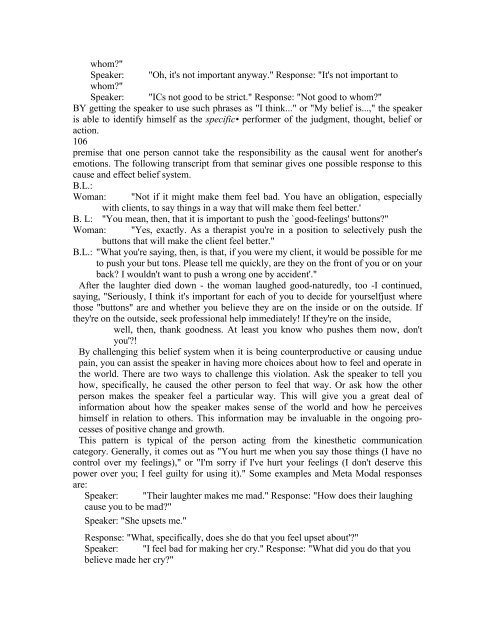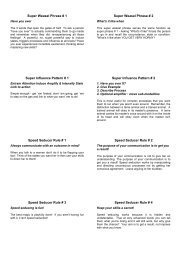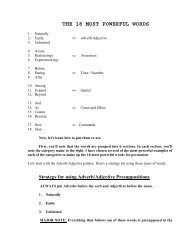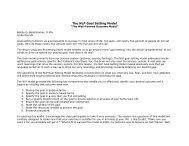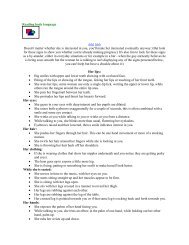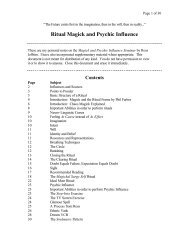A Pragmatic Guide To Communication & Change.pdf - NLP Info Centre
A Pragmatic Guide To Communication & Change.pdf - NLP Info Centre
A Pragmatic Guide To Communication & Change.pdf - NLP Info Centre
- No tags were found...
You also want an ePaper? Increase the reach of your titles
YUMPU automatically turns print PDFs into web optimized ePapers that Google loves.
whom?"<br />
Speaker: "Oh, it's not important anyway." Response: "It's not important to<br />
whom?"<br />
Speaker: "ICs not good to be strict." Response: "Not good to whom?"<br />
BY getting the speaker to use such phrases as "I think..." or "My belief is...," the speaker<br />
is able to identify himself as the specific• performer of the judgment, thought, belief or<br />
action.<br />
106<br />
premise that one person cannot take the responsibility as the causal went for another's<br />
emotions. The following transcript from that seminar gives one possible response to this<br />
cause and effect belief system.<br />
B.L.:<br />
Woman: "Not if it might make them feel bad. You have an obligation, especially<br />
with clients, to say things in a way that will make them feel better.'<br />
B. L: "You mean, then, that it is important to push the `good-feelings' buttons?"<br />
Woman: "Yes, exactly. As a therapist you're in a position to selectively push the<br />
buttons that will make the client feel better."<br />
B.L.: "What you're saying, then, is that, if you were my client, it would be possible for me<br />
to push your but tons. Please tell me quickly, are they on the front of you or on your<br />
back? I wouldn't want to push a wrong one by accident'."<br />
After the laughter died down - the woman laughed good-naturedly, too -I continued,<br />
saying, "Seriously, I think it's important for each of you to decide for yourselfjust where<br />
those "buttons" are and whether you believe they are on the inside or on the outside. If<br />
they're on the outside, seek professional help immediately! If they're on the inside,<br />
well, then, thank goodness. At least you know who pushes them now, don't<br />
you'?!<br />
By challenging this belief system when it is being counterproductive or causing undue<br />
pain, you can assist the speaker in having more choices about how to feel and operate in<br />
the world. There are two ways to challenge this violation. Ask the speaker to tell you<br />
how, specifically, he caused the other person to feel that way. Or ask how the other<br />
person makes the speaker feel a particular way. This will give you a great deal of<br />
information about how the speaker makes sense of the world and how he perceives<br />
himself in relation to others. This information may be invaluable in the ongoing processes<br />
of positive change and growth.<br />
This pattern is typical of the person acting from the kinesthetic communication<br />
category. Generally, it comes out as "You hurt me when you say those things (I have no<br />
control over my feelings)," or "I'm sorry if I've hurt your feelings (I don't deserve this<br />
power over you; I feel guilty for using it)." Some examples and Meta Modal responses<br />
are:<br />
Speaker: "Their laughter makes me mad." Response: "How does their laughing<br />
cause you to be mad?"<br />
Speaker: "She upsets me."<br />
Response: "What, specifically, does she do that you feel upset about'?"<br />
Speaker: "I feel bad for making her cry." Response: "What did you do that you<br />
believe made her cry?"


